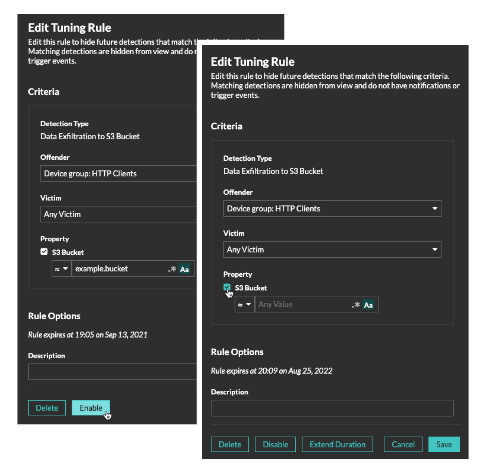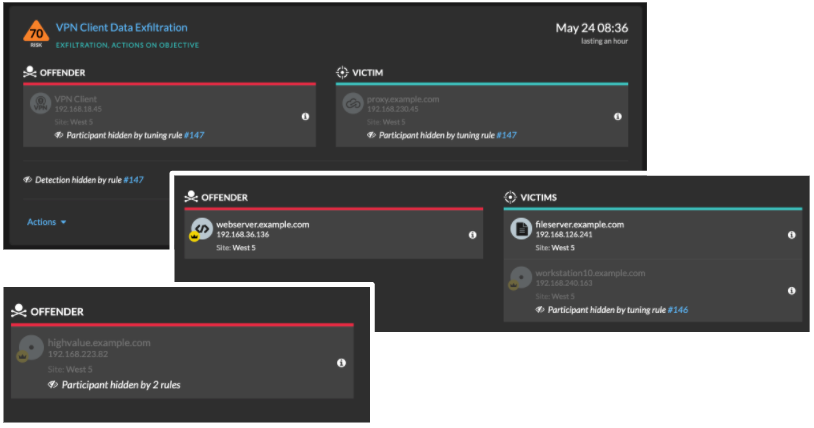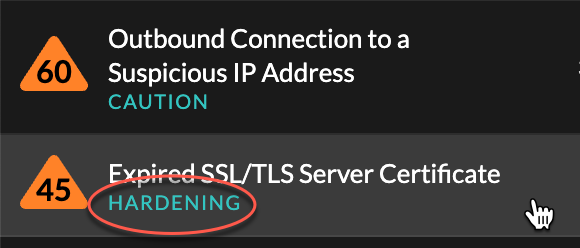Hide detections with tuning rules
Tuning rules enable you to hide detections that match specified criteria.
To avoid creating redundant rules, make sure to first add information about your network environment to the ExtraHop system by specifying tuning parameters.
Learn more about tuning detections.
Create a tuning rule
Create tuning rules to streamline your detection list by specifying criteria that hide past, present, and future detections that are of low-value and do not require attention.
Before you begin
Users must have full write or higher privileges to create a tuning rule.Learn about tuning best practices.
Add a tuning rule from a detection card
If you encounter a low-value detection, you can create a tuning rule directly from a detection card to hide similar detections in the ExtraHop system.
Before you begin
Users must have full write or higher privileges to tune a detection.Learn about tuning best practices.
Add a tuning rule from a hardening detection
Click a hardening detection to view a summary of all assets, detection properties, and network localities associated with that detection type. You can filter the summary by clicking any of the associated values, and then create a tuning rule to hide detections based on the displayed results.
Before you begin
Users must have full write or higher privileges to tune a detection.Learn more about filtering and tuning hardening detections.
Learn about tuning best practices.
Add a tuning rule from the Tuning Rules page
Create tuning rules to hide detections by detection type, participant, or specific detection properties.
Before you begin
Users must have full write or higher privileges to tune a detection.Learn about tuning best practices.
Tuning rule criteria
Select from the following criteria to determine which detections are hidden by a tuning rule.
- Detection type
- You can create a tuning rule that applies to a single detection type, or choose to have the rule apply to all detection types. Rules that encompass all detection types are typically reserved for activity associated with vulnerability scanners.
- Participants
- Identify participants in a tuning rule by IP address, device name, or network locality.
For detections with multiple offenders you can include a list of IP
addresses or CIDR blocks, or reference a device group. You can also create
tuning rules that hide a single participant without hiding an entire
detection.

You can opt to hide all offenders or all victims. For example, you can hide the offender in a noisy scan detection regardless of the victim participants.
- Detection properties
- Create a tuning rule that hides detections by a specific property. For
example, you can hide Rare SSH Port detections for a single port number, or
Data Exfiltration to S3 Bucket detections for a specific S3 bucket.

Manage Tuning Rules
You can edit the criteria or extend the duration of a rule, re-enable a rule, and disable or delete a rule.
At the top of the page, click the Systems Settings icon ![]() and select
Tuning Rules.
and select
Tuning Rules.
Click on a tuning rule in the Tuning Rules table to open the Edit Tuning Rule panel. Update participants, rule criteria, or properties to adjust the scope of the rule. Click the buttons at the bottom of the panel to delete, disable, enable, or extend the duration of a rule.

- After you disable or delete a rule, the rule expires immediately and associated triggers and alerts resume.
- After you disable a rule, previously hidden detections remain hidden; ongoing detections appear.
- Deleting a rule displays previously hidden detections.
You can temporarily display hidden detections and participants on the Detections page by selecting the Show Hidden Detections checkbox, without disabling the tuning rules. Each hidden detection or participant includes a link to the associated tuning rule, and displays the username of the user that created the rule. If the detection or participant is hidden by multiple rules, the number of rules that apply appears.


Thank you for your feedback. Can we contact you to ask follow up questions?